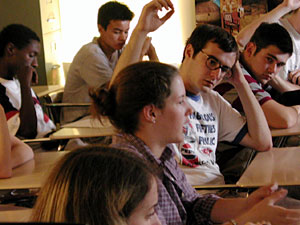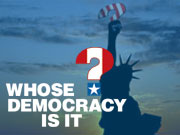|
Audio
Photos
Resources
Your Voice
|
Is democracy cool to kids?
November 6, 2003
 |
| Central High School students are talking about democracy. (Courtesy of Ethan Cherin) |
St. Paul, Minn. — A glimpse of the future of American democracy can be found in a cramped classroom in St. Paul. It's an economics class at Central High School and these 16-, 17- and 18-year-olds have lots of opinions about democracy.
According to their economics teacher, Ethan Cherin, they are among the smartest kids in the state. Despite their intellectual curiosity and good grades, Cherin says he sees an apathy among young Americans when it comes to political participation.
 | |||
"The world goes on. The mall is open, their car gets gas in it. Nothing affects them to such a degree that they have been pushed to really get involved and change things," he says.
Cherin says most of the kids he sees are cynical about the most basic form of participation: voting.
"I don't think the government is fostering a sense that we want to hear your voice," says Ariel Neerson, 17, a senior. "It's they want to hear certain people's voices that support what they already want to do. 'We don't want confrontation, we don't want what you really think. We just want what makes it easy.' And I think this really fosters a sense that voting doesn't really matter, so why would you do it?"
Ariel's sense of hopelessness is borne out in national statistics, according to University of Maryland social scientist Mark Hugo Lopez.
"Young people just aren't movtivated to vote. They feel their vote doesn't count," says Lopez, research director at the Center for Information and Research on Civic Learning and Engagement -- CIRCLE -- an organization focused solely on youth and political participation.
"They also are likely to say that candidates don't listen to them. Candidates don't come to their communities, candidates are more interested in talking to older, wealthier voters than they are in talking to younger voters."
Lopez's research shows that voter turnout during presidential election years between 18- and 24-year-olds has declined by 13 percentage points since 1972, the first year 18- to 21-year-olds were first permitted to vote. In 1972, just over 50 percent of that age group turned out to vote. By 2000, the number was down to just below 40 percent.
 | |||
Lopez says the drop in the youth vote has been much steeper than the decline in turnout for older adults. He says the good news is that his research also shows increasing youth voter turnout is very simple.
"Just asking a young person to vote is likely to increase their probability of voting by anywhere to five to eight percentage points," he says. "This is true across college going and minority youth. This is true in large presidential elections, and also in small school board elections."
Lopez says since many young people consider themselves political independents, another way to increase the number of young voters could be to offer them more choices.
His data shows an eight percentage point spike in youth turnout in the 1992 presidential election. Lopez says it's not possible to know the precise reason for the increase, but theorizes it could be due to an interest in third-party candidate Ross Perot, the seemingly young and hip Bill Clinton, and MTV's Rock The Vote turnout initative.
Central High senior Andy Danakowski, 18, will be eligible to vote in the 2004 presidential election. He says he'd like to see a three-way race. Danakowski says he's wary of career politicians and dislikes what he sees as the "business of politics."
 | |||
"It kind of seems like being in office kind of corrupts the politician becuase they become a politician and not a citizen. I think it's too bad we don't have people motivated enough to want to run for office from the community. I just think it's too bad when our only choice is between two party candidates, and they're limited to that."
Classmate Eva Cohen, 16, says she likes the Green Party. She says it's the only party that has a strong vision for change and has the country's best interests at heart.
Though Cohen won't be able to vote for a couple of years, she says there are lots of ways for kids to be politically engaged.
"Like through like being in contact with your legislators, and attending protests, and just being involved and concerned, and empowered that you can create change through your actions, and your voice through speaking out. And you know, going to the polls once a year, and you know, checking a couple of little boxes, and dropping your ballot in, that's not enough. People need to really be passionate and care and believe they can create change," Cohen says.
Cohen's broad view of democracy is nothing new.
Thomas Jefferson preached that democracy isn't sustainable if it's not practiced every day of the year.
 | |||
That Jeffersonian ideal drives an effort to engage young people based at the Humphrey Institute at the University of Minnesota.
It's called Public Achievement.
"I like to think about the work as the craft of doing citizenship."
Dennis Donovan is Public Achievement's international coordinator. Projects include Humboldt High School in St. Paul, where students worked with school officials to get lights and bleachers for their football stadium.
Donovan says giving students the choice to decide what issues they want to focus on, take part in, or not, is critical to the program's approach.
"Most of the time, when young people are in a school, they are doing things a certain way that's usually dictated by someone else. In Public Achievement, they control what they're doing and why they're doing it and also the learning that takes place, which is very powerful. It's real. It's not a dress rehearsal for citizenship, it's the real thing."
Donovan says by working on issues that are imporant to them over a period of years, young people will become more interested in voting.
Anne Marie Bedwany, 18, a senior at St. Bernard's in St. Paul, has been involved in Public Achievement for four years. She says her experience has provided her with a deeper understanding of her role in democracy.
"I think it's up to the youth now, of today's world, to make a change, and make a difference. Because as everyone says, we are the future, we are going to be the next leaders."
Bedwany says she'll be voting for the first time in the 2004 election.
|
News Headlines
|
Related Subjects
|

